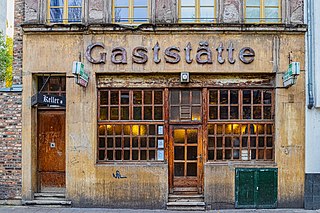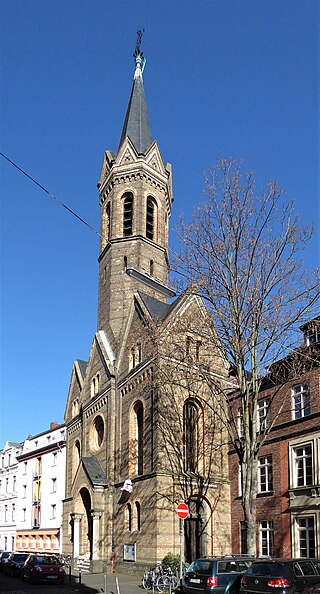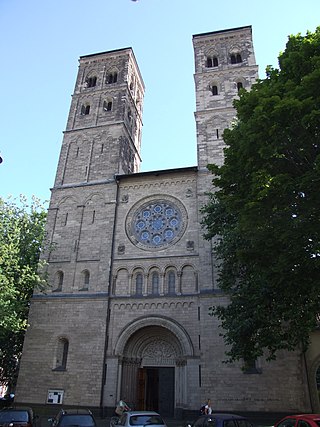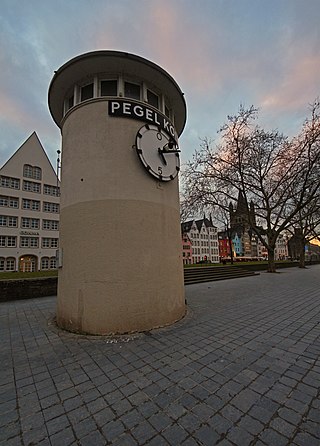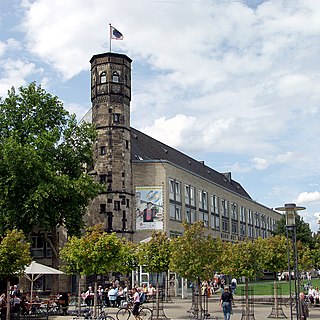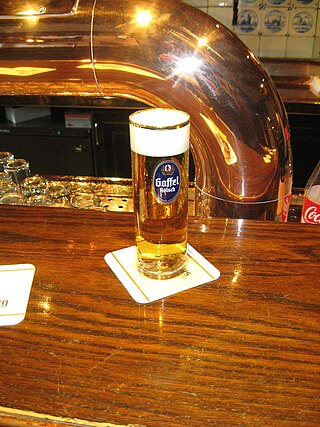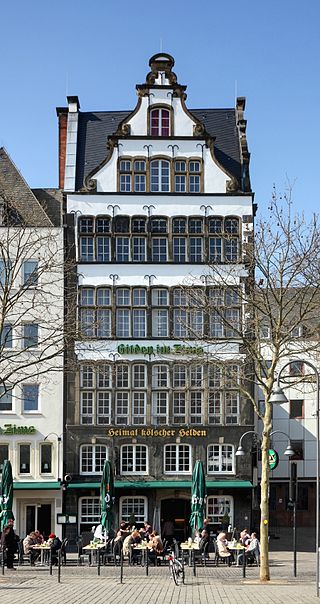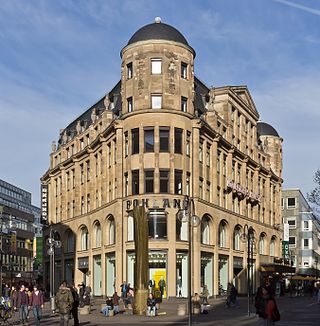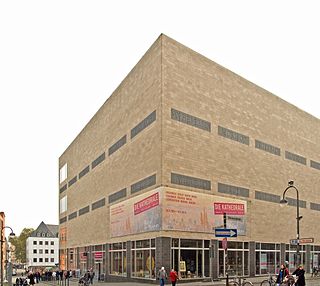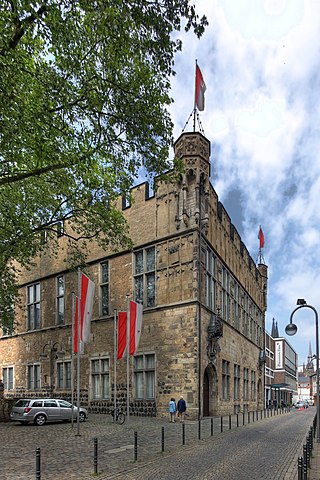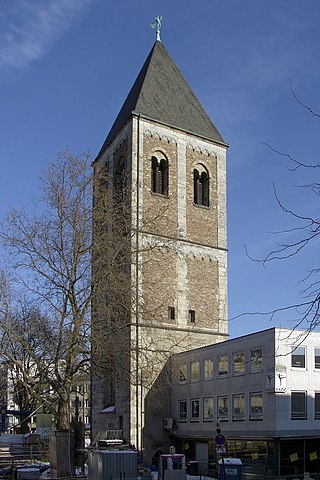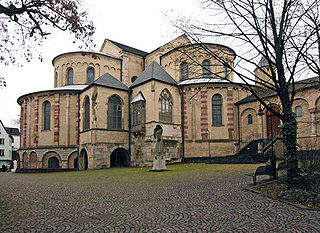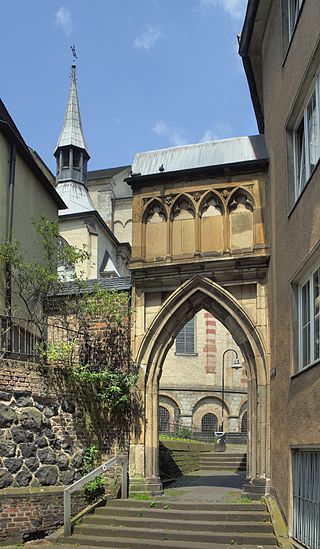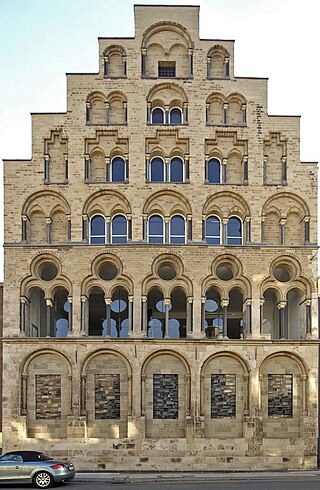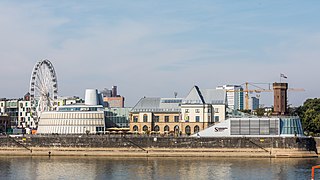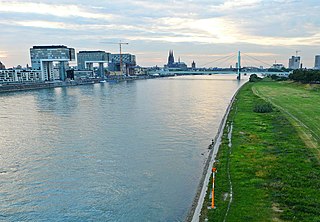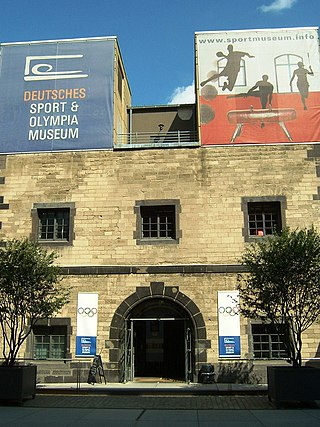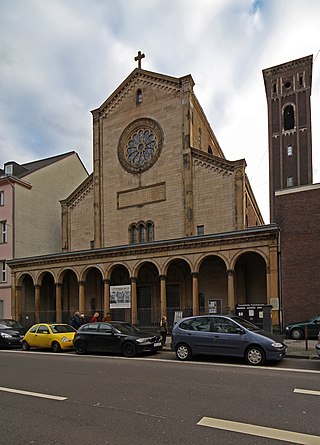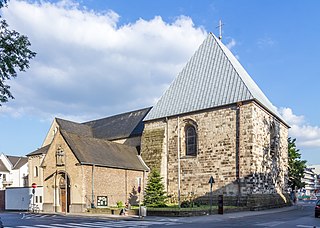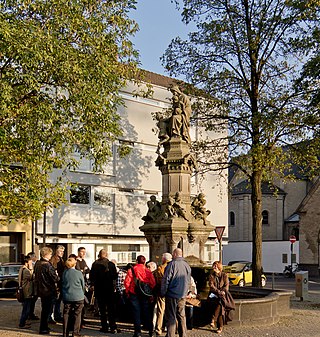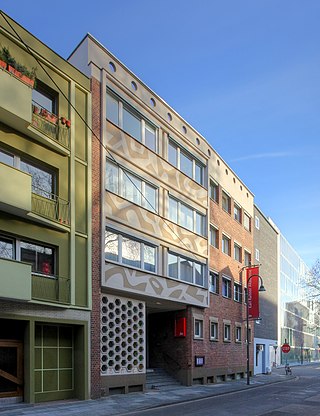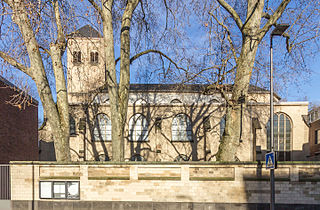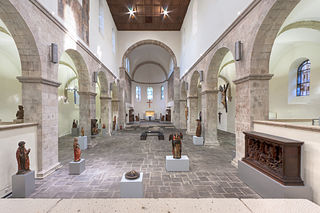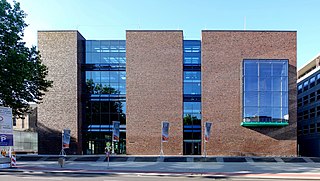Self-guided Sightseeing Tour #3 in Cologne, Germany
Legend
Guided Free Walking Tours
Book free guided walking tours in Cologne.
Guided Sightseeing Tours
Book guided sightseeing tours and activities in Cologne.
Tour Facts
9 km
151 m
Experience Cologne in Germany in a whole new way with our free self-guided sightseeing tour. This site not only offers you practical information and insider tips, but also a rich variety of activities and sights you shouldn't miss. Whether you love art and culture, want to explore historical sites or simply want to experience the vibrant atmosphere of a lively city - you'll find everything you need for your personal adventure here.
Activities in CologneIndividual Sights in CologneSight 1: Lommi-Brunnen
The Lommerzheim, also known as Lommi, is a restaurant in Cologne-Deutz that was run in its original form from 1959 to New Year's Eve 2004 by the innkeepers Hans and Annemie Lommerzheim. The combination of a dilapidated and neglected-looking building, the interior furnishings, which apparently never been renovated, and the idiosyncrasies of the landlord couple earned the pub the reputation as the "most Cologne of all Cologne pubs". After several years of vacancy, the restaurant was renovated in the style of the furnishings of the old restaurant and reopened in March 2008.
Sight 2: Sankt Johannes Deutz
St. John's Church is a Protestant church in Cologne-Deutz. It is one of the two church buildings of the Evangelical parish of Cologne-Deutz/Poll in the church district of Cologne-Mitte of the Evangelical Church in the Rhineland.
Sight 3: St. Heribert
The Roman Catholic parish church of St. Heribert is a three-aisled pillar basilica in the Cologne district of Deutz. In the vernacular, the church is also known as Düxer Cathedral. The showpiece of the church is the Heribertschrein, which preserves the relics of Archbishop Heribert of Cologne and founder of Deutz Abbey.
Sight 4: Pegel Köln
The Cologne gauge is located in Cologne's Altstadt-Nord on the left bank of the Rhine and measures the water level of the Rhine at river kilometre 688. It is one of 22 gauges on the Rhine and, along with the Kaub gauge, the most important. It is operated by the Rhine Waterways and Shipping Authority.
Sight 5: Hänneschen-Theater
Hänneschen-Theater is a traditional puppetry-theatre in Cologne, Germany. It was established in the year 1802. The stage is situated in a building on Eisenmarkt in downtown Cologne. The pieces are set in Knollendorf, a fictional village somewhere in the outskirts of Cologne. The popular puppets represent fictional characters who embody typical traits of cologne people, so Tünnes and Schäl, Hänneschen and Bärbelchen, as well as other unique characters. In addition to the ever-changing pieces that are staged for adults and children, the puppet shows are also an important part of the Cologne Carnival. The carnival puppet session is each year a loving parody of a conventional Carnival session.
Sight 6: Stapelhaus
The Cologne Stapelhaus, named after the Cologne Stapelrecht, stands in front of the choir of the Groß St. Martin church. Today, the Stapelhaus is considered a symbol of the trading metropolis of Cologne, although little is known about its actual former function.
Sight 7: Great St. Martin Church
Get Ticket*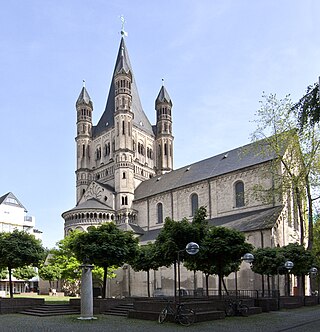
The Great Saint Martin Church is a Romanesque Catholic church in Cologne, Germany. Its foundations rest on remnants of a Roman chapel, built on what was then an island in the Rhine. The church was later transformed into a Benedictine monastery. The current buildings, including a soaring crossing tower that is a landmark of Cologne's Old Town, were erected between 1150-1250. The architecture of its eastern end forms a triconch or trefoil plan, consisting of three apses around the crossing, similar to that at St. Maria im Kapitol. The church was badly damaged in World War II; restoration work was completed in 1985.
Sight 8: Tünnes und Schäl
Hänneschen-Theater is a traditional puppetry-theatre in Cologne, Germany. It was established in the year 1802. The stage is situated in a building on Eisenmarkt in downtown Cologne. The pieces are set in Knollendorf, a fictional village somewhere in the outskirts of Cologne. The popular puppets represent fictional characters who embody typical traits of cologne people, so Tünnes and Schäl, Hänneschen and Bärbelchen, as well as other unique characters. In addition to the ever-changing pieces that are staged for adults and children, the puppet shows are also an important part of the Cologne Carnival. The carnival puppet session is each year a loving parody of a conventional Carnival session.
Sight 9: Kallendresser
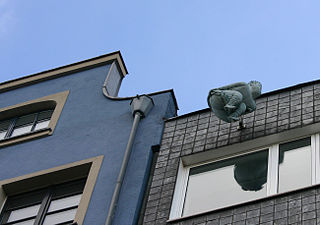
The Kallendresser has played a role as a figure in Cologne since the Middle Ages. It can be found, for example, on the consoles of the figures in Cologne's town hall tower, which depict men stretching their bare buttocks towards the viewer.
Sight 10: Gaffel-Haus
The Gaffel Haus is the oldest building on the Alter Markt in Cologne's Altstadt-Nord and has been home to a brewery of the Cologne private brewery Gaffel since 1987, which today bears the name "Zum Prinzen".
Sight 11: Gilden im Zims
Das als Baudenkmal geschützte heutige Brauhaus Gilden im Zims am Kölner Heumarkt, ist ein im Stil der Spätrenaissance errichtetes Bürgerhaus aus der Mitte des 16. Jahrhunderts.
Sight 12: Archäologische Zone / Neubau Jüdisches Museum „MiQua“
MiQua. LVR-Jewish Museum in the Archaeological Quarter of Cologne is a museum under construction that will house an approximately 6,000 m² archaeological excavation area on and around the Rathausplatz in the center of the city of Cologne. The site displays archaeological relics from the entire 2000-year history of the city. The Roman period and the medieval Jewish quarter are particularly relevant. On the town hall square, which was no longer built on after the destruction in the Second World War, a museum for the Roman and Jewish history of the city is currently being built.
Sight 13: Kardinal Frings
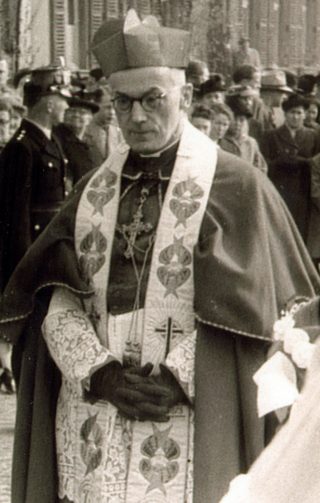
Josef Cardinal Frings was a German Roman Catholic clergyman, Archbishop of Cologne and Cardinal.
Sight 14: Jupp-Schmitz-Denkmal
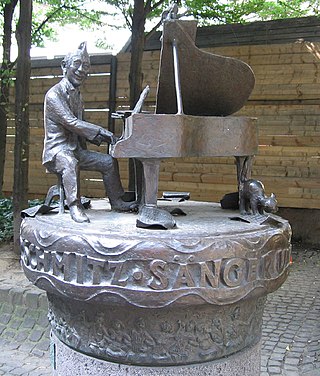
Jupp Schmitz was a German entertainer, pop singer and Krätzchen singer. Among his best-known songs are Am Aschermittwoch ist alles vorbei, Wer soll das zahl? and There is still soup there.
Sight 15: Palatium
Palatium is the name of a commercial building in Cologne's Altstadt-Nord, which is located on Schildergasse near Hohe Straße.
Sight 16: Duftmuseum im Farina-Haus
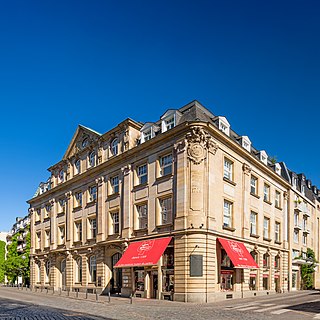
The Fragrance Museum in the Farina House is within sight of the Cologne City Hall and opposite the Wallraf-Richartz Museum in Cologne and is housed in the birthplace of the Eau de Cologne in the original production rooms of the 18th century.
Sight 17: Wallraf-Richartz-Museum & Foundation Corboud
The Wallraf–Richartz Museum is an art museum in Cologne, Germany, with a collection of fine art from the medieval period to the early twentieth century. It is one of the three major museums in Cologne.
Sight 18: Old St Albans
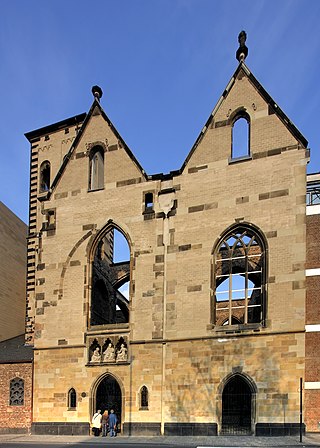
Alt St. Alban is the preserved ruin of a former parish church on Cologne's Quatermarkt. It is one of the oldest Romanesque church buildings in Cologne.
Sight 19: Gürzenich
The Gürzenich is a festival hall in the center of the old town of Cologne. The name of Gürzenich is the name of which the profile structure was built in the 15th century on which the property was built. Since the beginning of the 19th century, the building complex for concerts, congresses, social and cultural events has been used.
Sight 20: Klein St. Martin
Klein St. Martin was a parish church in Cologne, which, together with the collegiate church of Groß St. Martin and many other churches and buildings, determined the Cologne Rhine panorama. The church was abolished during secularization and demolished around 1824. The church tower was preserved and rebuilt after destruction in the Second World War.
Sight 21: St. Maria im Kapitol
Get Ticket*St. Maria im Kapitol is an 11th-century Romanesque church located in the Kapitol-Viertel in the old town of Cologne, Germany. The name “im Kapitol“ refers to the Roman temple for the Capitoline Triad that was built on today’s site of the church in the first century. The Catholic church is based on the Church of the Nativity in Bethlehem, was dedicated to St. Mary and built between 1040 and 1065. It is one of twelve Romanesque churches built in Cologne during this period.
Sight 22: Dreikönigenpförtchen
The hidden Epiphany Gate is the only one of the gates of Cologne's many former monastic immunity districts to have been preserved. At the walls of these monasteries and monasteries, the city's legislative power and tax sovereignty ended. The gate connects the Lichhof of the Church of St. Maria in the Capitol with Marienplatz. The small gate is not to be confused with the medieval Three Kings Gate, a gateway of the city fortifications on the Rhine side that was demolished in 1854.
Sight 23: Overstolzenhaus
The Overstolzenhaus in Cologne is one of the oldest buildings in the city of Cologne, is the oldest surviving patrician house in Germany along with the Trier Dreikönigenhaus and was mainly used as a residential building. It is somewhat hidden in Rheingasse 8, Altstadt-Süd.
Sight 24: Malakoffturm
The Malakoff Tower is a relic of the Prussian Rhine embankment fortification built from 1848 to 1858 at the Holzmarkt in Cologne.
Sight 25: Der Tauzieher
The Tauzieher is a limestone sculpture by Nikolaus Friedrich which was erected in 1911 in Rheinauhafen, Cologne. It depicts a man making a heavy rope or hawser fast to a bollard and is 6.5 metres in height. In 1980, it was listed as one of the first heritage sites in Cologne.
Sight 26: Chocolate Museum
Get Ticket*The Cologne Chocolate Museum is a special museum for chocolate in the Cologne district of Altstadt-Süd. The exhibition building, located on a peninsula in the Rheinauhafen, houses a collection on the history of chocolate and a permanent exhibition on modern chocolate production, among other things.
Sight 27: Rheinauhafen
The Rheinauhafen is a 15.4 hectares urban regeneration project in Cologne, Germany, located along the river Rhine between the Südbrücke and Severinsbrücke, just south of the inner city's historic old town.
Sight 28: Deutsches Sport- und Olympiamuseum
The German Sport & Olympic Museum is a museum in Cologne that presents the history of sports from antiquity to modern times. It is located in Cologne's Rheinauhafen within the Cologne-Altstadt-Süd district.
Sight 29: St. Maria Lyskirchen
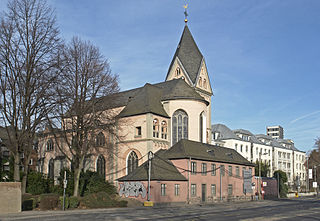
St. Maria Lyskirchen is one of twelve Romanesque churches in Cologne, Germany.
Sight 30: Trinitatiskirche
The Trinitatiskirche is the oldest newly built Protestant church in Cologne on the left bank of the Rhine. It is located in the southern old town on Filzengraben, near the Heumarkt. Due to the depopulation of the city centre, it no longer holds regular community services, but it does host central events of the Protestant Church Association for the Cologne region, services on special occasions, concerts and art exhibitions. The Trinity Church serves as a place of worship for the Protestant deaf community. The cultural partner is the WDR Radio Choir.
Sight 31: St. Georg
St. Georg's Church is one of twelve Romanesque churches in the city of Cologne, Germany.
Sight 32: Hermann-Joseph Brunnen
The Hermann-Josef-Brunnen is a sculptural fountain originally designed as a running fountain at the Waidmarkt in the Cologne district of Altstadt-Süd. It was donated in 1894 by the Cologne Beautification Association and designed and implemented by the sculptor Wilhelm Albermann. The sculptures depict scenes from the life and legend of the so-called "apple saint" Hermann Joseph von Steinfeld. The fountain has been registered in the list of monuments of the city of Cologne since 1 July 1980 under number 164.
Sight 33: Wasserturm Hotel Cologne
Built between 1868 and 1872, the listed former water tower in Cologne's Altstadt-Süd district is one of the oldest surviving water towers and has been used as a luxury hotel since 1990.
Sight 34: Karl-Rahner-Akademie
The Karl Rahner Academy is a Catholic city academy in Cologne. It sees itself as an independent discussion forum in the "Kulturquartier am Neumarkt" in the centre of Cologne and is aimed at people who are interested in theological, philosophical, cultural and social issues. A high proportion of participants with a university degree are reached, even beyond the borders of the city of Cologne and the Catholic Church.
Sight 35: St. Peter
St Peter's Church is a Roman Catholic church in Cologne, run by the Jesuits. The painter Rubens was baptised in the church and his father was later buried there. Rubens' Crucifixion of St Peter is on display in the church. It was commissioned in 1638 by the Cologne art collector and businessman Eberhard Jabach and was hung in the church in 1642 after Rubens'death. The building also houses the 'Kunst-Station Sankt Peter', a centre for contemporary art, music, and literature.
Sight 36: St. Cecilia's Church
St. Cecilia's Church is one of the twelve Romanesque churches in Cologne’s old city, maintained by the Foundation of Romanesque Churches in Cologne. The present building, little changed since its inception, dates from 1130-60. Since 1956, the church has been the home of the Schnütgen Museum for medieval art.
Sight 37: Museum Schnütgen
The Schnütgen Museum in Cologne is devoted to Christian religious art, mainly medieval, but some parts of the collection, such as its textiles and prints, extend from antiquity to the modern period. In 1906, the collection of Alexander Schnütgen was donated to the city, and the collection has continued to expand, so that until the opening of a new building in 2010, only about 10% of its 13,000 items could be displayed. Now some 2,000 objects are on display in 1900 sq. metres of gallery space, with an additional 1300 sq. metres for special exhibitions. Schnütgen (1843–1918) was a Catholic priest and theologian; according to the museum website "Up to now people tell stories about his zealous and sometimes crafty collection tactics".
Sight 38: Rautenstrauch-Joest-Museum
The Rautenstrauch-Joest Museum is a museum of ethnography in Cologne, Germany. It was reopened in 2010. The museum arose from a collection of over 3500 items belonging to ethnographer Wilhelm Joest. After his death in 1897, the collection was left to his sister Adele Rautenstrauch.
Share
How likely are you to recommend us?
Disclaimer Please be aware of your surroundings and do not enter private property. We are not liable for any damages that occur during the tours.
GPX-Download For navigation apps and GPS devices you can download the tour as a GPX file.
